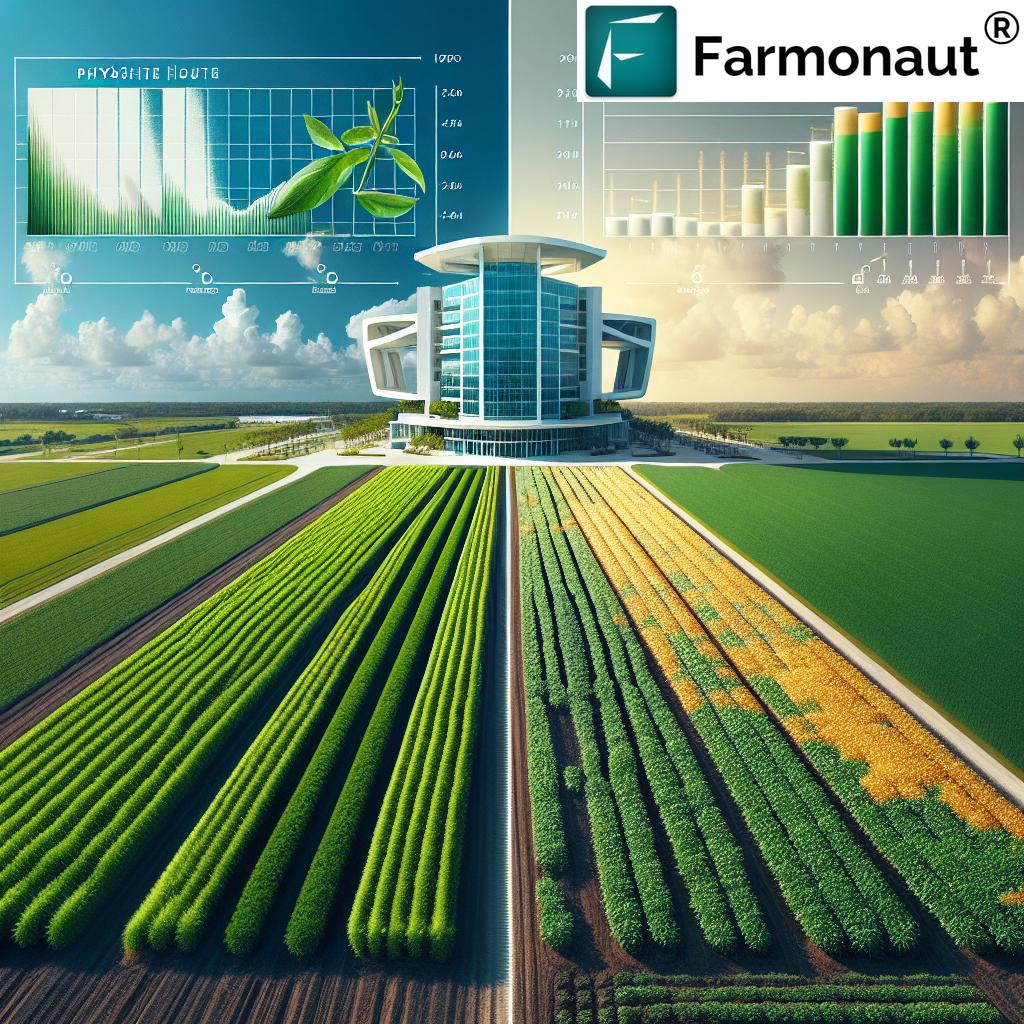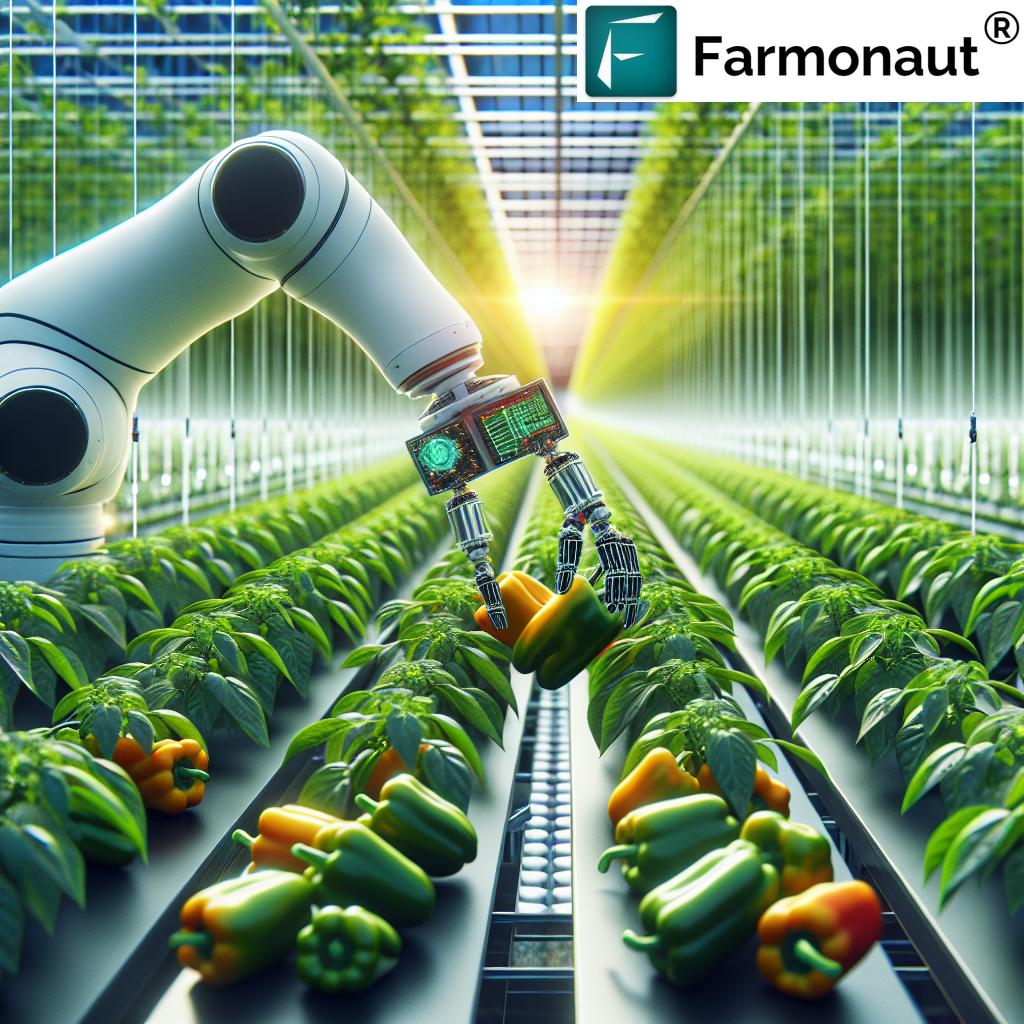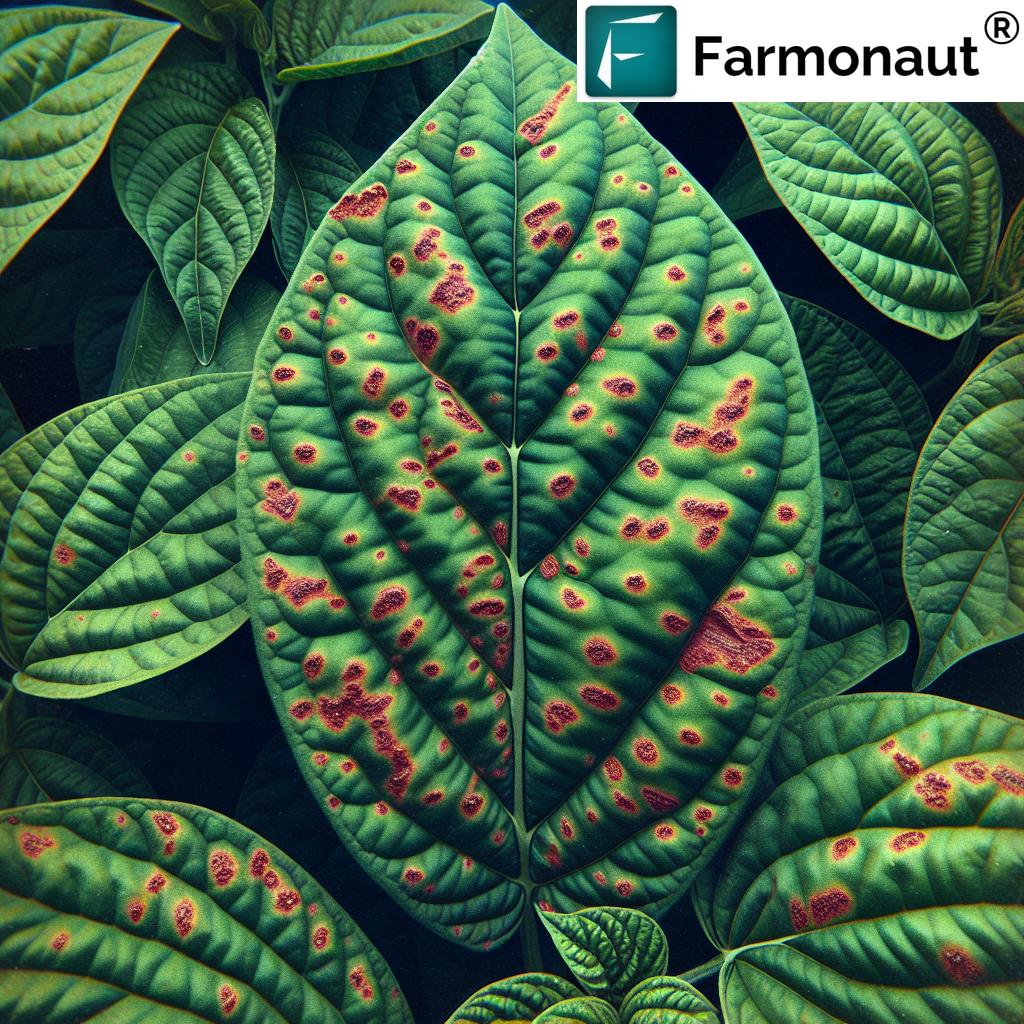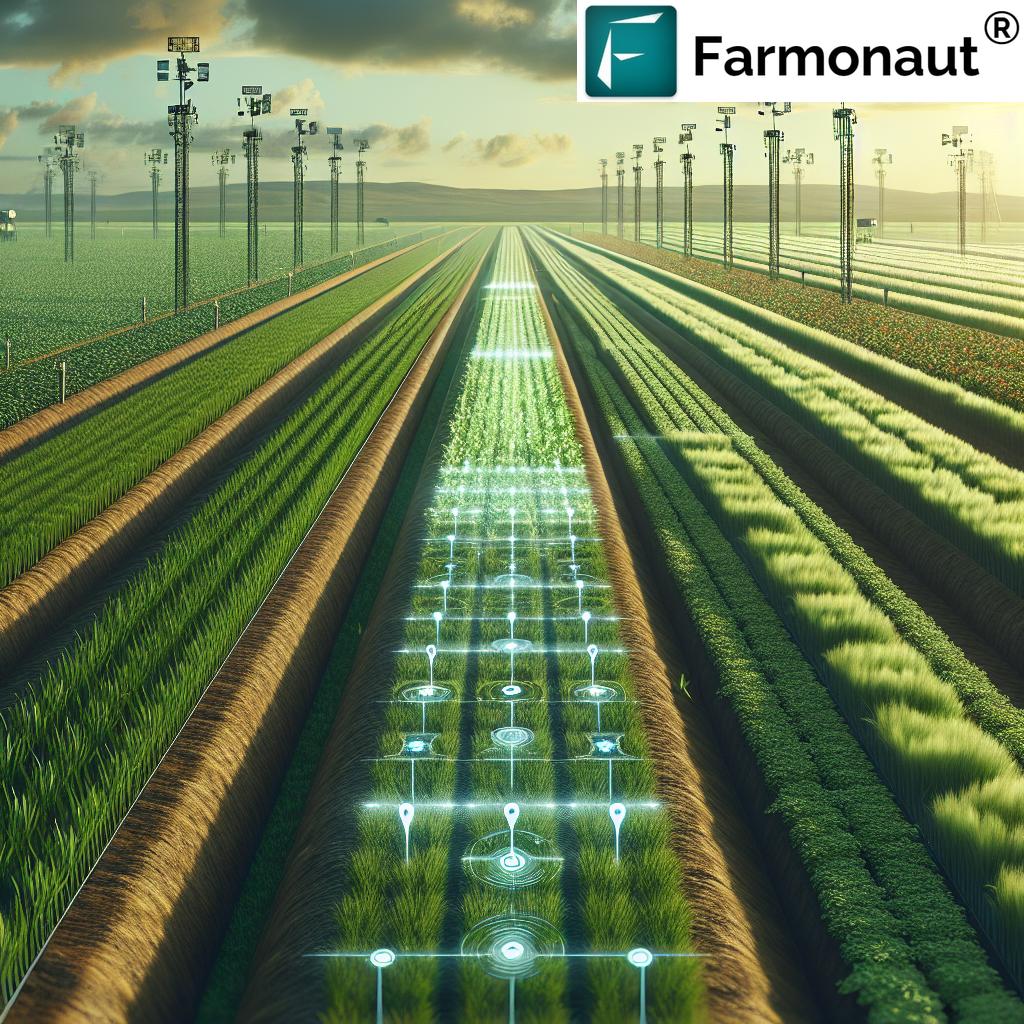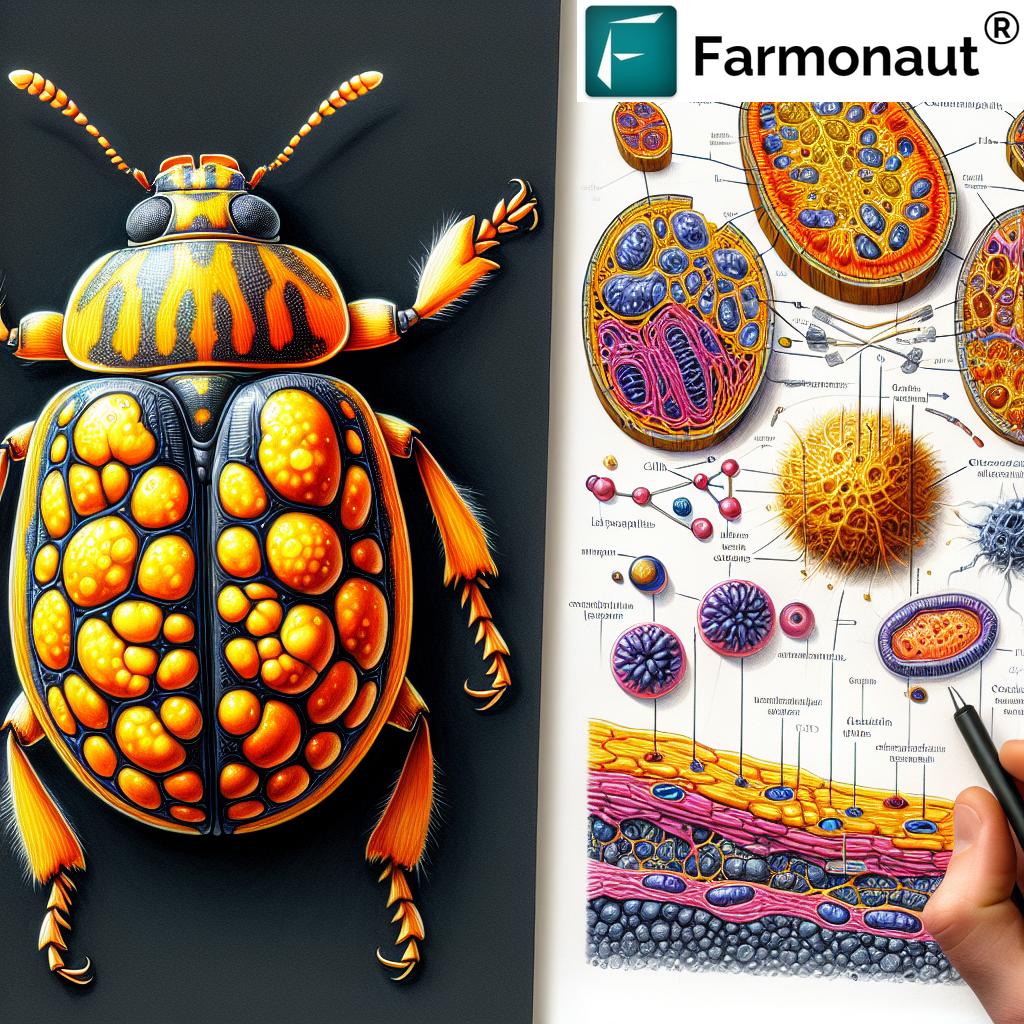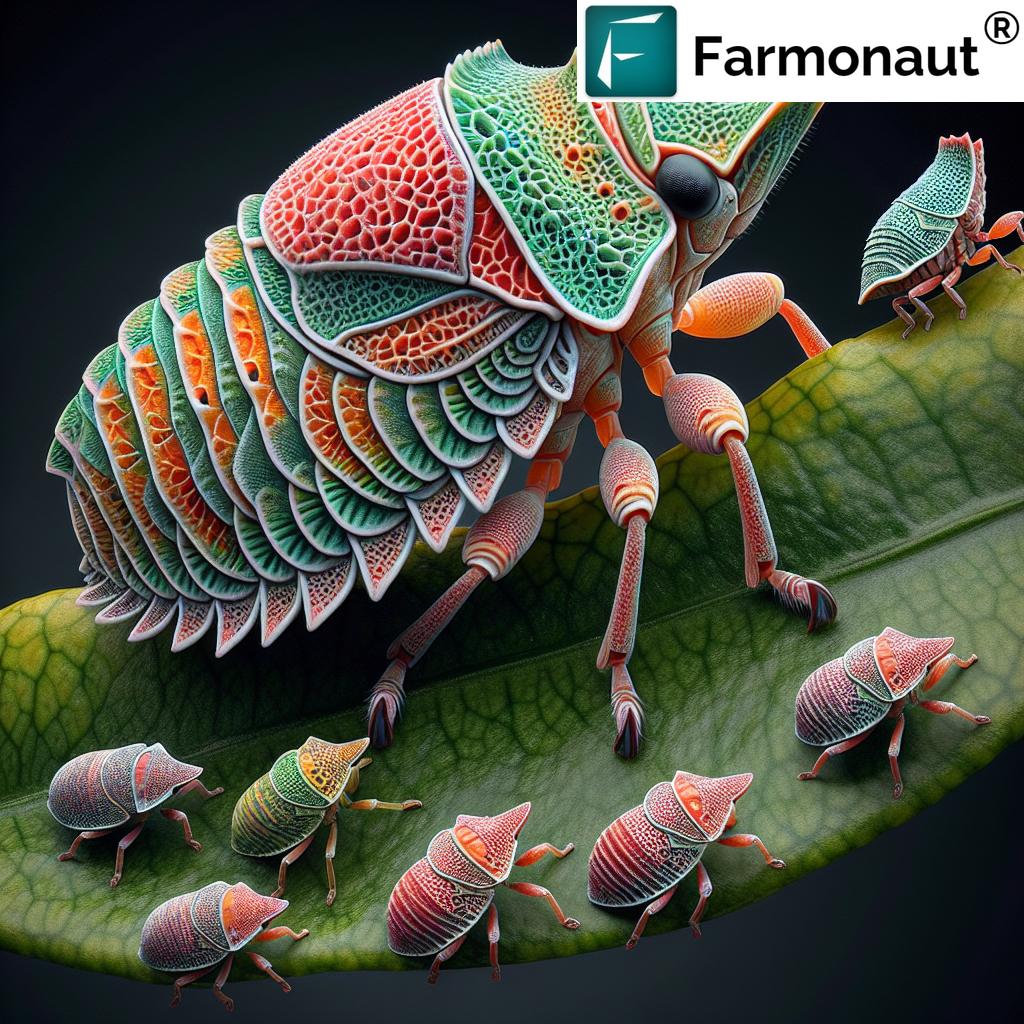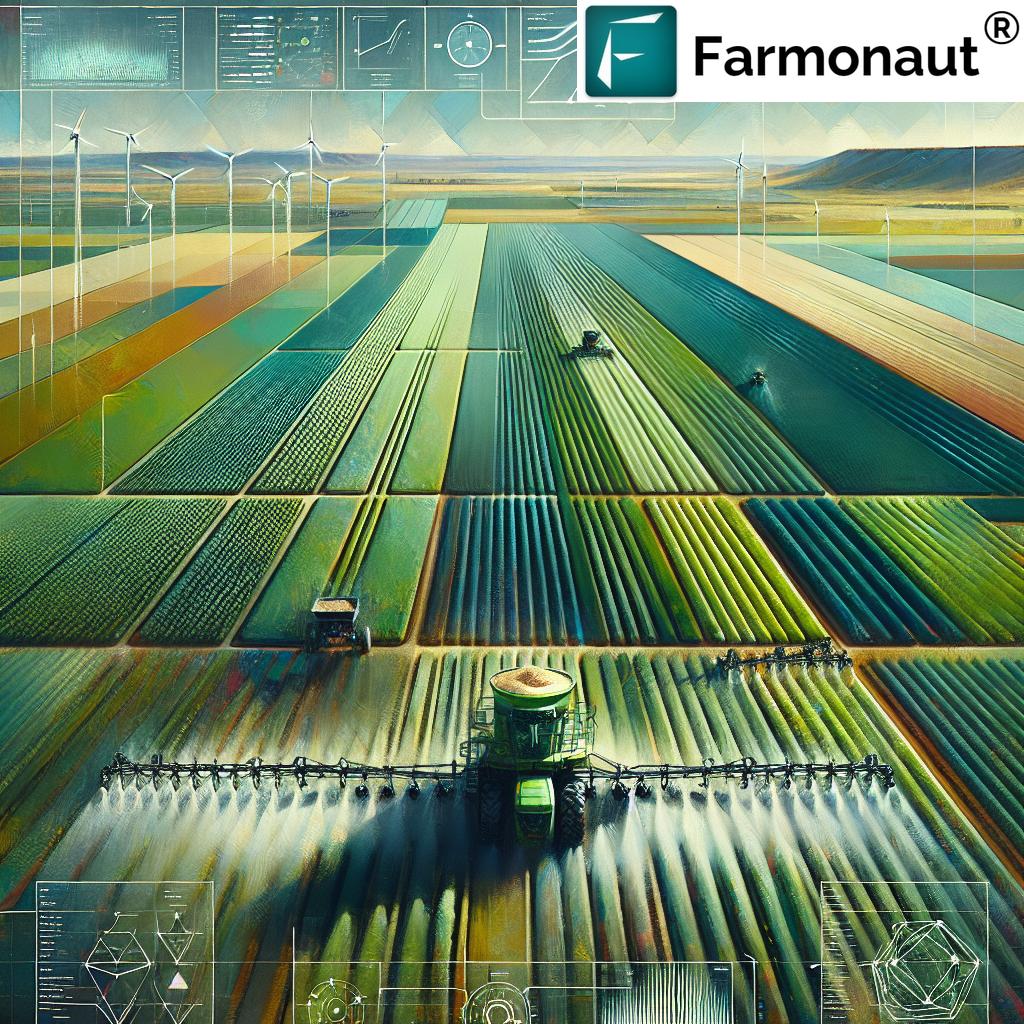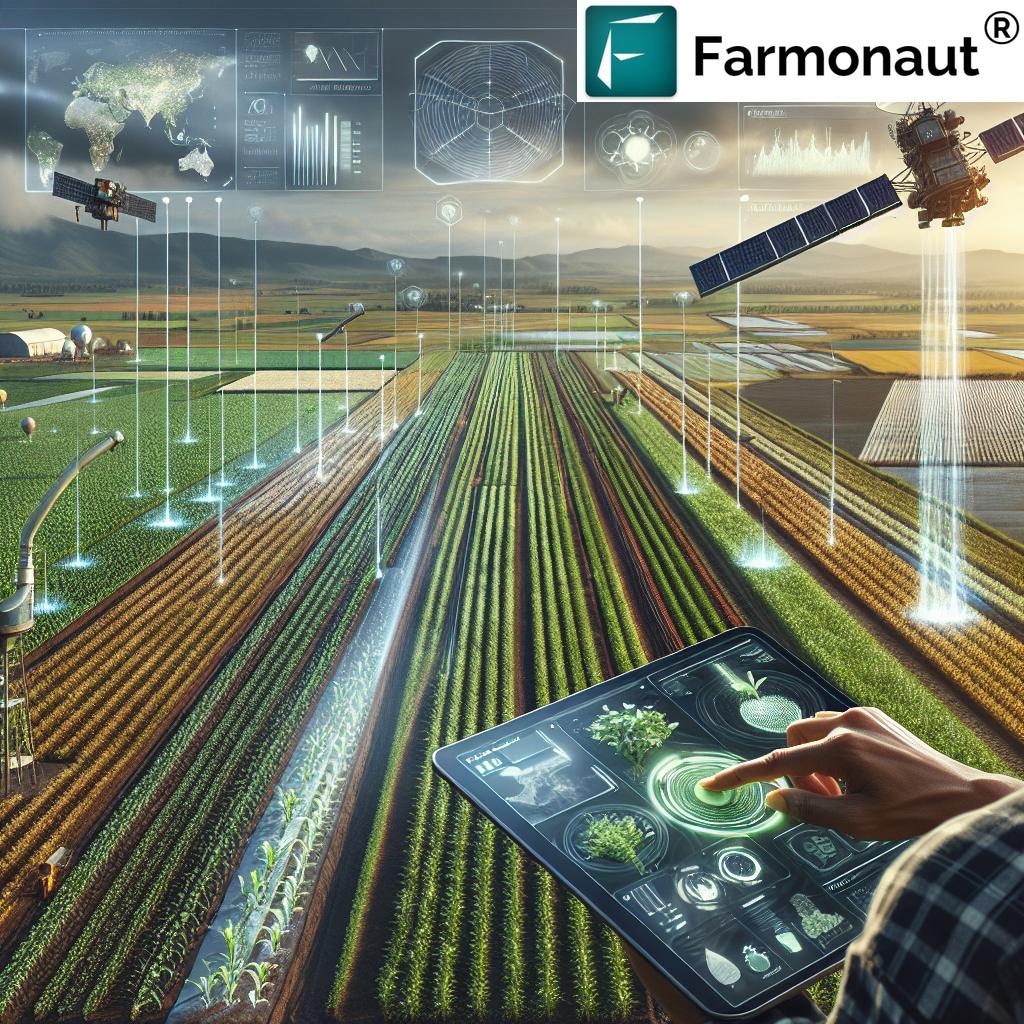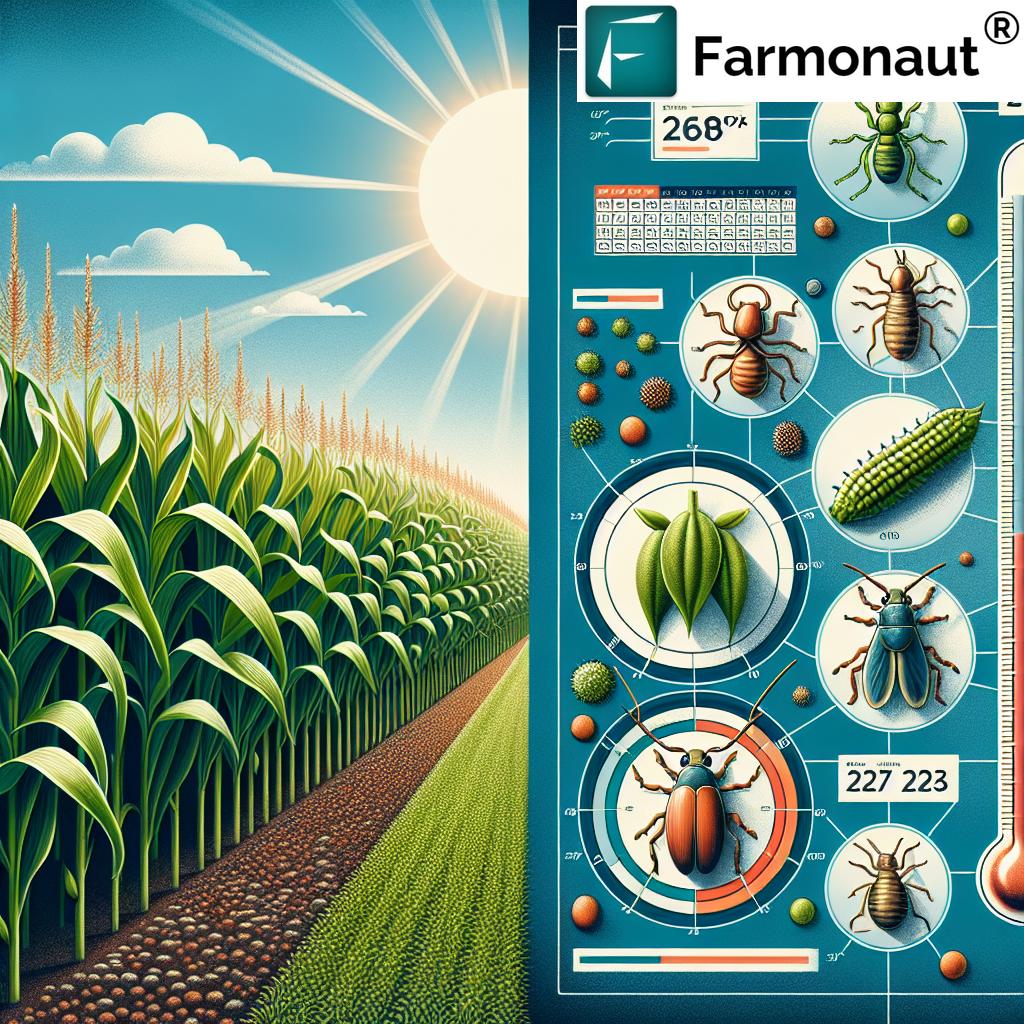
Maximizing Crop Yield: Harnessing Growing Degree Days and Pest Management Models for Integrated Field Operations
In the ever-evolving world of agriculture, we at Farmonaut are committed to bringing you the latest advancements in crop management techniques. Today, we’re diving deep into two crucial concepts that can significantly impact your farming success: Growing Degree Days (GDD) and Integrated Pest Management (IPM) models. These powerful tools, when used in conjunction with our satellite-based monitoring systems, can revolutionize your field operations and boost your crop yields.
Understanding Growing Degree Days (GDD)
Growing Degree Days, often abbreviated as GDD, is a weather-based indicator used to predict plant and insect development rates. This concept is founded on the idea that the growth and development of plants and insects are closely tied to the accumulation of heat over time.
The Science Behind GDD
GDD is calculated by taking the average of the daily maximum and minimum temperatures compared to a base temperature, below which plant growth is minimal. The formula is typically expressed as:
GDD = [(Tmax + Tmin) / 2] – Tbase
Where:
- Tmax is the daily maximum temperature
- Tmin is the daily minimum temperature
- Tbase is the base temperature for the specific crop or pest
If the calculated GDD is negative, it’s typically set to zero for that day, as most organisms don’t develop below their base temperature.
Importance of GDD in Agriculture
Understanding and utilizing GDD can provide numerous benefits to growers:
- Predicting Plant Development Stages: GDD helps forecast when plants will reach various growth stages, such as flowering or maturity.
- Optimizing Planting Dates: By tracking GDD, farmers can determine the best time to plant their crops for optimal growth.
- Improving Pest Management: GDD can predict insect pest life cycles, allowing for more targeted and effective pest control measures.
- Enhancing Crop Management: Farmers can time their field operations, such as fertilizer application or irrigation, based on GDD predictions.
Integrated Pest Management (IPM) Models
Integrated Pest Management is a holistic approach to pest control that focuses on long-term prevention through a combination of techniques. IPM models incorporate various factors, including GDD, to predict pest development and optimize control strategies.
Key Components of IPM Models
- Pest Identification: Accurate identification of pests is crucial for effective management.
- Monitoring: Regular field observations and use of traps to track pest populations.
- Threshold Levels: Establishing economic thresholds to determine when pest control action is necessary.
- Prevention Methods: Implementing cultural practices that discourage pest infestation.
- Control Methods: Using a combination of biological, chemical, and mechanical control methods as needed.
Integrating GDD into IPM Models
GDD plays a crucial role in many IPM models by helping predict pest development stages. This integration allows for more precise timing of control measures. Here’s how it works:
- Biofix Establishment: A biofix point is set, often corresponding to the first sustained catch of adult pests in traps or the first observation of pest activity.
- GDD Accumulation: From the biofix date, GDD is accumulated using the appropriate base temperature for the pest species.
- Development Prediction: Based on known GDD requirements for various life stages, the model predicts when eggs will hatch, larvae will develop, or adults will emerge.
- Treatment Timing: Control measures can be timed to target the most vulnerable life stage of the pest, increasing effectiveness and reducing unnecessary pesticide use.
Case Study: Codling Moth Management in Apple Orchards
Let’s examine how GDD and IPM models work together in managing one of the most significant pests in apple orchards: the codling moth.
The Codling Moth Life Cycle
The codling moth (Cydia pomonella) typically goes through several generations per growing season. Understanding its life cycle is crucial for effective management:
- Overwintering: Larvae overwinter in cocoons, often in tree bark crevices.
- Spring Emergence: Adults emerge in spring when temperatures warm up.
- Egg Laying: Females lay eggs on leaves or developing fruit.
- Larval Development: Upon hatching, larvae bore into fruit, causing significant damage.
- Pupation: Mature larvae leave the fruit to pupate, often in bark crevices.
- Multiple Generations: Depending on the climate, there can be 2-3 generations per season.
Implementing GDD and IPM for Codling Moth Control
- Establish Biofix: Set the biofix date when the first sustained moth catch occurs in pheromone traps.
- Calculate GDD: Begin accumulating GDD from the biofix date, using a base temperature of 10°C (50°F) for codling moth.
- Predict Life Stages: Use GDD accumulations to predict key events:
- First egg hatch: typically occurs at 220-250 GDD
- Peak egg hatch: around 500 GDD
- Second generation biofix: approximately 1000 GDD
- Time Control Measures: Apply control methods based on these predictions:
- Mating disruption techniques can be implemented before the first moth flight
- Ovicides can be applied just before predicted egg hatch
- Larvicides are most effective when timed with peak egg hatch
- Monitor and Adjust: Continue monitoring trap catches and fruit damage throughout the season, adjusting the model as necessary.
Farmonaut’s Role in Enhancing GDD and IPM Implementation
At Farmonaut, we recognize the power of combining GDD and IPM models with advanced satellite technology. Our platform offers several features that can significantly enhance your pest management strategies:
- Satellite-Based Crop Monitoring: Our high-resolution satellite imagery allows for large-scale crop health assessment, helping identify potential pest hotspots before they become major issues.
- Weather Data Integration: We provide accurate, field-specific weather data, crucial for precise GDD calculations.
- GDD Calculator: Our built-in GDD calculator simplifies the process of tracking heat accumulation for various crops and pests.
- Pest Development Models: We offer customized pest development models for key crops, integrating GDD data with pest life cycle information.
- Alert Systems: Receive timely notifications when GDD thresholds are reached, prompting scouting or treatment activities.
- Historical Data Analysis: Access past seasons’ GDD and pest data to improve future planning and predictions.
To experience these features firsthand, visit our app or explore our API offerings for integration with your existing systems.
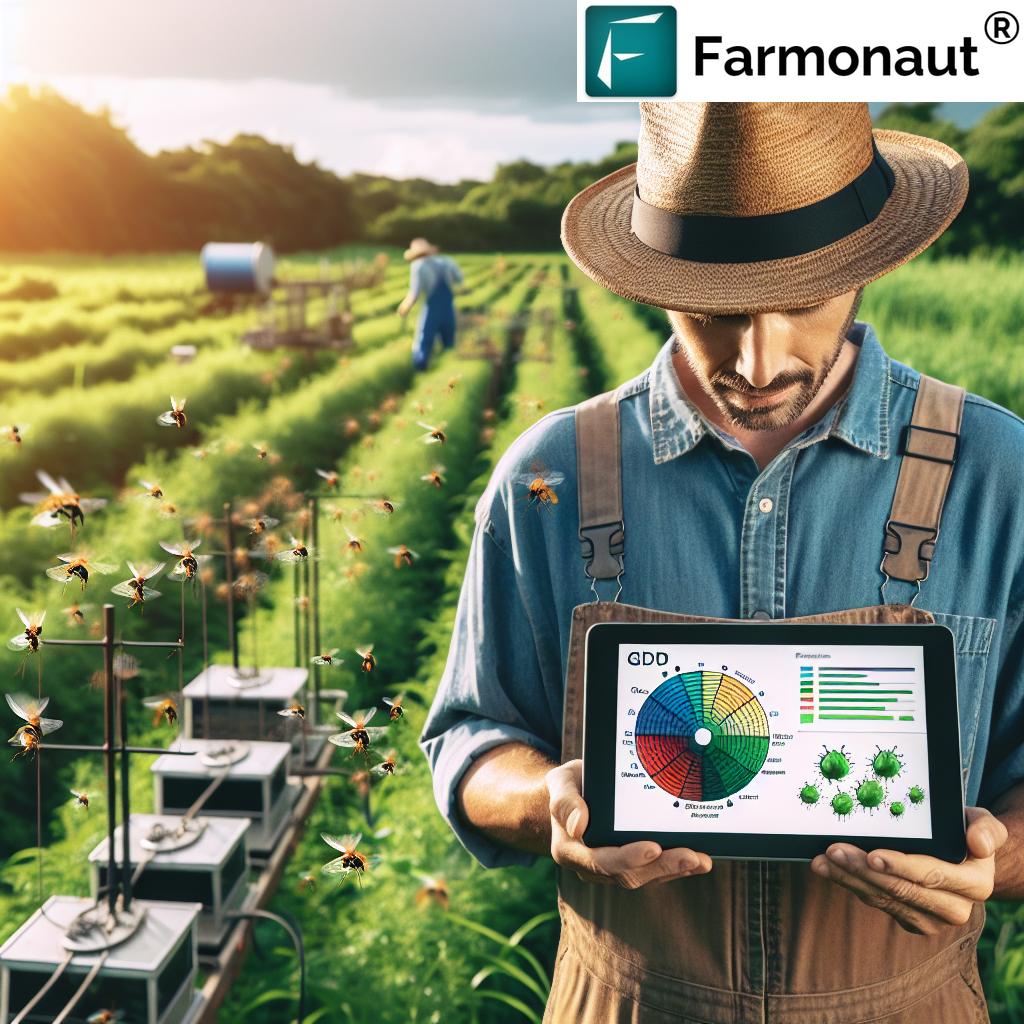
Expanding Beyond Codling Moth: Other Pest Management Applications
While we’ve focused on the codling moth as an example, the principles of using GDD in IPM models apply to a wide range of pests and crops. Let’s explore a few more examples:
Colorado Potato Beetle Management
The Colorado potato beetle (Leptinotarsa decemlineata) is a major pest in potato fields. Here’s how GDD can be applied:
- Biofix: Usually set at the first observation of adult beetles in the field.
- GDD Calculation: Use a base temperature of 10°C (50°F).
- Key GDD Points:
- 150-200 GDD: Peak egg laying
- 300-350 GDD: Peak of first instar larvae
- 650-700 GDD: Peak of fourth instar larvae (most damaging stage)
- Management Actions: Time insecticide applications or release of biological control agents based on these GDD milestones.
European Corn Borer in Maize
For managing European corn borer (Ostrinia nubilalis) in maize fields:
- Biofix: Set at the first sustained catch of moths in pheromone traps.
- GDD Calculation: Use a base temperature of 10°C (50°F).
- Key GDD Points:
- 200-250 GDD: Beginning of egg laying
- 350-400 GDD: Peak egg hatch
- 1000-1100 GDD: Emergence of second generation moths
- Management Strategies: Time scouting activities and insecticide applications based on these predictions.
Integrating GDD and IPM into Your Farm Management Plan
To effectively incorporate GDD and IPM models into your farm management strategy, consider the following steps:
- Identify Key Pests: Determine which pests pose the most significant threats to your crops.
- Research GDD Requirements: For each pest and crop, identify the base temperature and GDD accumulations associated with various life stages.
- Implement Monitoring Systems: Set up weather stations, pheromone traps, and regular scouting routines.
- Utilize Technology: Leverage platforms like Farmonaut to automate GDD calculations and receive alerts.
- Develop Action Plans: Create detailed plans for each pest, outlining control measures to be implemented at specific GDD milestones.
- Train Your Team: Ensure all farm personnel understand the basics of GDD and IPM to effectively implement your strategies.
- Keep Detailed Records: Document pest observations, treatments, and their effectiveness for future reference and model refinement.
- Stay Informed: Keep up with the latest research on pest biology and control methods to continually improve your management strategies.
The Future of GDD and IPM: Advancements and Challenges
As we look to the future, several exciting developments and challenges are on the horizon for GDD and IPM implementation:
Advancements
- Machine Learning Integration: AI algorithms are being developed to improve the accuracy of pest prediction models by incorporating more variables and learning from historical data.
- Remote Sensing Technologies: Advanced satellite and drone imagery can detect early signs of pest infestation, allowing for even more proactive management.
- Precision Agriculture: Integration of GDD and IPM models with precision agriculture technologies allows for site-specific pest management within fields.
- Climate Change Adaptation: Models are being refined to account for changing climate patterns and their effects on pest life cycles.
Challenges
- Climate Variability: Increasing climate variability may make traditional GDD models less reliable, requiring more adaptive approaches.
- Pest Adaptation: Pests may develop resistance to control methods or adapt to changing climates, necessitating continuous model updates.
- Data Management: The increasing amount of data available can be overwhelming, requiring robust systems for data integration and interpretation.
- Technology Adoption: Ensuring widespread adoption of these technologies, especially among smallholder farmers, remains a challenge.
Farmonaut’s Commitment to Advancing Pest Management
At Farmonaut, we’re dedicated to addressing these challenges and pushing the boundaries of what’s possible in pest management. Our ongoing research and development efforts focus on:
- Enhanced Predictive Models: We’re continuously refining our GDD and pest development models to improve accuracy across diverse climatic conditions.
- User-Friendly Interfaces: Our goal is to make complex pest management strategies accessible to farmers of all scales through intuitive mobile and web applications.
- Integration of Multiple Data Sources: We’re working on seamlessly integrating satellite imagery, ground-based sensors, and user observations to provide a comprehensive view of field conditions.
- Customized Solutions: Recognizing that every farm is unique, we’re developing tools that allow for easy customization of pest management strategies based on local conditions and practices.
To stay updated on our latest developments and access our cutting-edge pest management tools, download our app from the Google Play Store or the Apple App Store.
Comparative Analysis: Traditional vs. Satellite-Based Pest Monitoring
To illustrate the advantages of Farmonaut’s satellite-based system in pest management, let’s compare it with traditional monitoring methods:
| Feature | Traditional Methods | Farmonaut’s Satellite-Based System |
|---|---|---|
| Accuracy | Varies based on sampling method and frequency | High accuracy with consistent, wide-area coverage |
| Coverage Area | Limited to manually scouted areas | Entire fields and regions can be monitored simultaneously |
| Real-time Data | Delayed, depends on scouting schedule | Near real-time data with frequent satellite passes |
| Integration with GDD Models | Manual calculations and integration | Automated integration of satellite data with GDD models |
| Cost-effectiveness | Labor-intensive and time-consuming | Cost-effective for large areas, saves time and resources |
| Ease of Use | Requires extensive field work and expertise | User-friendly interface with minimal training required |
As this comparison shows, Farmonaut’s satellite-based system offers significant advantages in terms of scale, efficiency, and integration with advanced pest management models.
Conclusion: Embracing the Future of Pest Management
The integration of Growing Degree Days and Integrated Pest Management models, powered by satellite technology, represents a significant leap forward in agricultural practices. By adopting these advanced techniques and tools, growers can:
- Improve the timing and efficacy of pest control measures
- Reduce unnecessary pesticide applications, promoting environmental sustainability
- Increase crop yields through more precise management of pest threats
- Save time and resources by leveraging technology for large-scale monitoring
- Make more informed decisions based on data-driven insights
At Farmonaut, we’re committed to empowering farmers with the tools and knowledge needed to implement these advanced pest management strategies effectively. By combining our satellite-based monitoring system with GDD calculations and IPM models, we’re helping create a more sustainable and productive future for agriculture.
We invite you to explore how Farmonaut can transform your pest management approach. Visit our developer documentation to learn more about integrating our powerful APIs into your existing farm management systems.
FAQs
-
Q: What is the primary benefit of using Growing Degree Days in pest management?
A: GDD helps predict pest development stages more accurately, allowing for better timing of control measures and more efficient use of resources. -
Q: How does Farmonaut’s satellite technology enhance pest management?
A: Our satellite technology provides wide-area crop health monitoring, enabling early detection of pest hotspots and integration with GDD models for precise pest forecasting. -
Q: Can GDD models be used for all types of pests?
A: While GDD models are widely applicable, they are most effective for pests whose development is primarily temperature-dependent. Some pests may require additional factors to be considered. -
Q: How often should I update my pest management strategies?
A: It’s recommended to review and update your strategies annually, considering the previous season’s data, new research findings, and any changes in pest behavior or climate patterns. -
Q: Is it difficult to implement GDD and IPM models on my farm?
A: While these models can be complex, tools like Farmonaut’s platform simplify the process, making it accessible even for those new to these concepts. Our user-friendly interface and support make implementation straightforward.
Ready to revolutionize your pest management approach? Subscribe to Farmonaut today and take the first step towards more efficient, effective, and sustainable farming practices.



